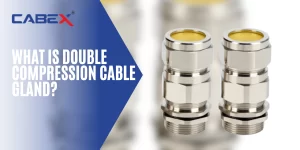A cable gland, also known as a cable connector or cable fitting, is a device used to secure and seal the end of a cable to a piece of equipment. It is typically made of metal or plastic and consists of two parts that screw together, clamping the cable and forming a tight seal to prevent moisture, dust, and other contaminants from entering the equipment.
How Many Types of Cable Gland?
There are several types of cable glands available in the market, including armoured cable glands, non-armoured cable glands, explosion-proof cable glands, strain relief cable glands, and spiral cable glands, among others. Each type of cable gland is designed to meet specific needs and requirements based on the application, cable type, and environmental conditions.
What Are Cable Glands Used For?
Cable glands are used for several purposes, including:
1. Cable management
Cable glands provide a secure and organized way to manage cables and wires, preventing them from becoming tangled or damaged.
2. Environmental protection
Cable glands help protect cables and wires from exposure to moisture, dust, dirt, and other environmental contaminants, which can cause corrosion or electrical interference.
3. Safety
Cable glands can help prevent accidents by securing cables and wires and reducing the risk of tripping or falling.
4.Electrical continuity
Cable glands provide a reliable electrical connection between the cable and the equipment, ensuring proper functioning and safety.
5. Compliance
Cable glands may be required by industry standards or regulations to meet safety or environmental requirements.
How to Use Cable Gland
Using a cable gland typically involves the following steps:
Choose the right cable gland for the job based on the cable diameter, the type of cable, and the environment it will be used in.
1. Strip the outer insulation of the cable to expose the inner conductors.
2. Insert the cable through the cable gland’s opening, making sure the conductors are properly aligned.
3. Tighten the gland’s locking mechanism to secure the cable in place.
4. Attach the other end of the cable to the equipment or terminal, making sure the electrical connections are properly made.
5. Check the gland’s seal to ensure it is tight and properly sealed to prevent moisture or other contaminants from entering the equipment.
It is important to follow the manufacturer’s instructions and recommended torque values when installing cable glands to ensure proper installation and safe operation.
Cable Gland Designations
Cable gland designations are codes or markings used to identify the type and size of a cable gland. The designation may include information such as the thread size, material, ingress protection (IP) rating, cable diameter range, and other specifications.
For example, a typical cable gland designation may look like “M20x1.5”, where M20 refers to the thread size and 1.5 refers to the pitch of the thread. Another example could be “IP68 10-14mm”, where IP68 refers to the level of protection against dust and water ingress, and 10-14mm refers to the cable diameter range that the gland is designed to accommodate.
Cable gland designations may vary depending on the manufacturer and the specific standard or specification being used. It is important to select a cable gland that is properly designated for the intended application to ensure proper fit, function, and safety.
How to Select Cable Gland

Selecting the right cable gland for a particular application involves considering several factors, including:
1. Cable type and diameter
What Is Cable Gland? The cable gland must be compatible with the cable type and diameter to provide a secure and proper fit.
2. Environmental conditions
The gland must be able to withstand the environmental conditions where it will be used, such as temperature, moisture, dust, and chemical exposure.
3. Ingress protection (IP) rating
The IP rating indicates the level of protection against dust and water ingress, and it should be chosen based on the environmental conditions and degree of protection required.
4. Material and construction
The gland material and construction should be selected based on the environmental conditions and compatibility with the cable and equipment.
5. Certifications and compliance
The gland may need to meet certain industry standards or regulatory requirements for safety and environmental protection.
6. Cable routing and termination
The gland should be selected based on the cable routing and termination requirements for the specific application.
It is important to consult with the manufacturer or supplier and follow their recommendations and guidelines when selecting a cable gland to ensure proper fit, function, and safety.
How to Install a Cable Gland?
Installing a cable gland involves the following steps:
1. Select the appropriate cable gland:
The cable gland you choose should be appropriate for the size of the cable you are using.
2. Mark the location:
Mark the location on the enclosure or equipment where you want to install the cable gland.
3. Drill a hole:
Use a drill to make a hole at the marked location. The size of the hole should be slightly smaller than the diameter of the cable gland.
4. Insert the cable gland:
Insert the cable gland into the hole and screw the outer part of the gland onto the enclosure or equipment.
5. Prepare the cable:
Strip the outer sheath of the cable to expose the wires inside. The length of the stripped portion should be as per the manufacturer’s recommendation.
6. Insert the cable:
Insert the cable through the inner part of the gland. The cable should be inserted until the outer sheath reaches the seal of the gland.
7. Tighten the gland:
Use a wrench or pliers to tighten the gland nut. This will create a tight seal around the cable, preventing any water or dust from entering the enclosure or equipment.
8. Check the installation:
Once you have installed the cable gland, make sure to check it for any signs of damage or leakage. You should also check that the cable is securely fastened and that the gland is properly tightened.
It is important to follow the manufacturer’s instructions when installing a cable gland, and to ensure that the installation is carried out by a qualified professional if you are unsure about any aspect of the process.
Why Cable Gland Earthing Is Required
To ensure proper electrical continuity and safety in electrical installations, one must ground or earth the cable gland, also known as cable gland earthing or cable gland grounding. Connecting a cable to equipment using a cable gland can create a potential difference between the equipment and the cable shield or armor, which can lead to electrical interference, noise, or even electrical shock hazards if the potential difference is not properly controlled or grounded.
Earthing a cable gland provides a low-impedance path for electrical current to flow to ground, effectively equalizing the potential difference between the equipment and the cable shield or armor. This helps to reduce electrical noise and interference, protect equipment from damage, and prevent electrical shock hazards.
In addition, cable gland earthing may be required by industry standards or regulations to meet safety and environmental requirements. Proper earthing of cable glands can ensure that electrical installations are safe and compliant with applicable standards and regulations.
What Is the Difference Between Armored Cable Glands and Non-Armored Cable Glands?
The main difference between armored cable glands and non-armored cable glands is that armored cable glands are designed to be used with cables that have metal armor or braid, while non-armored cable glands are used with cables that do not have any armor or braid.
What Is Armored Cable Gland? Armored cable glands have a special design that allows them to securely grip the cable’s metal armor or braid, providing strain relief and protecting the cable from damage. They may also have additional features, such as an inner seal, to provide environmental protection and a secure electrical connection.
What Is Non-armored Cable Gland? Non-armored cable glands, on the other hand, are designed to grip the outer sheath or insulation of the cable, providing strain relief and preventing damage to the cable. They may also have features, such as a sealing washer, to provide environmental protection and a secure electrical connection.
The choice between armored and non-armored cable glands depends on the type of cable being used and the specific requirements of the application. Armored cable glands are typically used with cables that are exposed to harsh environmental conditions, while non-armored cable glands may be used with cables that do not require additional protection.
What is industrial cable glands & cable armour?
Industrial cable glands are devices that are used to secure and protect cables in harsh and challenging environments. They provide a secure and reliable connection between the cable and the equipment, while also protecting the cable from environmental factors such as moisture, dust, and vibrations.
One important feature of industrial cable glands is the ability to accommodate cable armour. Cable armour refers to the metal braid or wire that is often used to provide additional protection to the cable. Armoured cables are commonly used in industrial applications where the cable may be exposed to mechanical stress, such as in mining, construction, and oil and gas industries.
Industrial cable glands are designed to securely grip and seal the cable armour, providing strain relief and protecting the cable from damage. This helps to ensure that the cable remains secure and functional, even in harsh and demanding conditions.
In addition to cable armour, industrial cable glands may also have other features such as environmental seals, multiple cable entries, and grounding provisions. These features help to ensure that the cable and equipment are protected from environmental hazards and that the electrical connections are safe and reliable.
Here are few frequently asked questions that people genrally asked:
Q. What material is cable gland?
A. Cable glands can be made of various materials, including brass, stainless steel, plastic, and aluminum, depending on the application and environmental conditions.
Q. What is the size of cable gland?
A. Cable gland sizes can vary depending on the application and cable diameter. They can range from small sizes for thin cables to large sizes for thicker cables.
Q. What is M25 cable gland size?
A. M25 cable gland size refers to a specific size standard for cable glands with a thread size of M25. This size is commonly used for cables with a diameter between 14-20mm.
Q. What is A1 and A2 cable gland?
A. A specific type of cable gland, commonly used in hazardous locations, refers to A1 and A2 cable gland. These cable glands prevent the spread of explosive gases by providing a barrier between the cable and the environment.
A1 and A2 cable glands are similar in design, but they differ in the type of barrier material used. A1 cable glands use a compression seal or compound to create a barrier, while A2 cable glands use a flameproof barrier such as a metal cone or flameproof compound.
Q. What is a cable gland and how does it work?
A. A cable gland is a mechanical device that is used to attach and secure the end of an electrical cable to an equipment or enclosure. It also provides environmental protection and ensures a safe and reliable connection. The cable gland works by providing a seal around the cable and entry point to prevent the ingress of moisture, dust, and other contaminants.
Q. What are the different types of cable glands available and how do I choose the right one for my application?
A. There are several types of cable glands available, including armored and non-armored glands, plastic and metal glands, and explosion-proof glands. The choice of cable gland depends on the specific requirements of the application, including cable type, environmental conditions, and regulations. Factors to consider when selecting a cable gland include cable diameter, thread size, and material compatibility.
Q. What materials are cable glands typically made from?
A. Cable glands can be made from a variety of materials, including brass, stainless steel, aluminum, plastic, and nickel-plated brass. The material chosen depends on the application, environmental conditions, and regulations.
Q. What is the purpose of cable gland earthing and how is it achieved?
A. Cable gland earthing is necessary to prevent electrical shock and ensure safe operation of the equipment. It is achieved by connecting the metallic components of the gland to the equipment’s earth terminal or grounding system. This creates a path for any electrical current to flow safely to earth, preventing electric shock or damage to the equipment.
Q. Can cable glands be used with both indoor and outdoor cables?
A. Yes, you can use cable glands with both indoor and outdoor cables. However, outdoor cable glands must provide additional protection against environmental factors such as moisture and UV radiation.
Q. How do I install a cable gland?
A. Installation procedures vary depending on the type of cable gland and application. Generally, the installation involves drilling a hole in the equipment, inserting the cable gland, tightening the gland’s locknut, and securing the cable. It is important to follow the manufacturer’s instructions and guidelines for proper installation.
Cabex India is a leading manufacturer and supplier of cable glands and other cable accessories. Cabex India offers a wide range of high-quality products to meet the needs of various industries, including oil and gas, marine, and construction. With a commitment to innovation and customer satisfaction, Cabex India has established itself as a trusted name in the cable gland industry.






